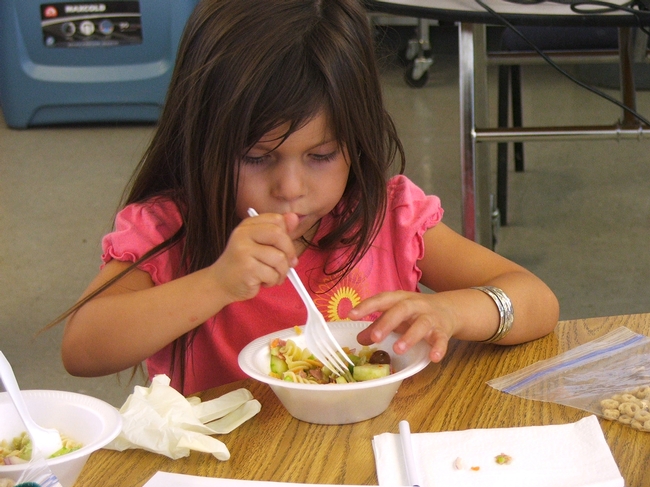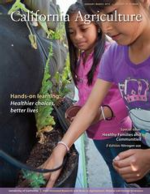Posts Tagged: Patricia Crawford
WIC food improves preschool children’s diet quality
In 2009, more fruits, vegetables, whole grains and low-fat milk were included in the food package provided by USDA's Special Supplemental Nutrition Program for Women, Infants and Children (WIC). As a result, the quality of diets improved for the roughly 4 million children who are served by WIC, according to a study by researchers at UCSF Benioff Children's Hospital in Oakland, UC San Francisco and UC Agriculture and Natural Resources' Nutrition Policy Institute.
“Although the findings only showed significant improvement for consumption of greens and beans, the other areas for which WIC has put in important efforts – increased consumption of whole fruits rather than fruit juice, increased whole grains – all show trends in the right direction,” said lead author June Tester, a physician at UCSF Benioff Children's Hospital Oakland, “and there is opportunity for further study in the future when more years have passed after this landmark change in the WIC package.”
Diets of children age 2 to 4 compared
For the UC study, which will be published in the May issue of Pediatrics journal, researchers analyzed the diets of 1,197 children, ages 2 to 4 years, from low-income households before and after the 2009 change in the food package.
The researchers used the National Health and Nutrition Examination Survey (NHANES) to compare a nationally representative sample from 2003 to 2008 with diets in 2011 to 2012. The researchers calculated the Healthy Eating Index (HEI-2010), which is a score with 100 possible points measuring adherence to dietary guidelines, from two 24-hour diet recalls. For children in households using WIC, this score increased from 52.4 to 58.3 after the policy change. After adjusting for characteristics in the sample and trends in the comparison group, the researchers showed that there was an increase of 3.7 points that was attributable to the WIC package change. This represents important evidence of an improvement in the diets for these children in WIC households.
Children don't eat enough green vegetables
“Vegetables are part of a healthful diet, but in general, children don't eat enough of them,” Tester said. Using the Healthy Eating Index, the researchers calculated the Greens and Beans score, which counts dark green vegetables and includes any legumes, such as beans and peas, that were not already counted as protein foods on a different score.
After the food package was changed, the Greens and Beans score increased for children in WIC but not for their counterparts. Roughly half of the children in WIC households had eaten some vegetables, whereas only one in five non-WIC children had consumed any green vegetables at all in the two days their parents were surveyed.
Important policy change
The change in the WIC food package is an important policy change in the effort to improve the quality of diets of young children, said Tester, a pediatrician.
Tester noted that the results of this study will be useful to the Institute of Medicine committee that is reviewing and assessing the nutritional status and food needs of the WIC-eligible population and the impact of the 2009 revision to WIC food packages. The committee will make recommendations for changing the food packages.
Establishing healthy eating patterns
“Increasing consumption of nutritious foods such as green leafy vegetables and whole grains in the low-income children served by WIC will help them establish healthier eating patterns for their future,” said co-author Patricia Crawford, UC Cooperative Extension nutrition specialist with UC ANR's Nutrition Policy Institute.
The switch from whole milk to low-fat milk was? ?well received by the clientele and did not result in decreased milk consumption among the preschoolers, noted Tester, Crawford and co-author Cindy Leung, postdoctoral scholar at UCSF Center for Health and Community.
This study is the first to report on the significant improvements in diet quality in young children associated with the WIC package change using a nationally representative sample, and the first to do so with the updated Healthy Eating Index (HEI-2010). The National Institutes for Health funded this study.
Para leer la versión en español de este artículo, visite http://ucanr.edu/sites/Spanish/Noticias/?uid=6735&ds=199.
UC initiative to help youth improve health, education and science literacy
Original research and literature reviews on these subjects appear in the January-March 2013 California Agriculture, UC’s peer-reviewed research journal of research in agriculture, natural and human resources (http://www.californiaagriculture.ucanr.edu).
UC Agriculture and Natural Resources (ANR) has launched a strategic initiative to help California youth. Called Healthy Families and Communities, it includes research and programs to encourage healthy lifestyles, boost science literacy, and foster positive youth development. Delaine Eastin, former State Superintendent of Public Instruction, notes, “At the end of the day, the Healthy Families and Communities Strategic Initiative is about change, scientifically measurable change, yielding concrete evidence of youth improvement due to these efforts.”
The facts underlying the initiative are startling. Nearly half of the state’s adults could be obese by 2030, according to a 2012 report by the nonprofit Trust for America’s Health. Obesity is linked to chronic illnesses, such as type 2 diabetes, heart disease and high blood pressure.
In addition, each year about 100,000 California youth who reach graduation age fail to graduate from high school, a predictor of their future social and financial difficulties as well as a missed opportunity for training skilled workers to replace those close to retirement. Finally, California’s eighth-grade science scores ranked 47th among the states in the National Assessment of Educational Progress’s 2011 report. A workforce with the knowledge and skills for scientific careers is critical to the state’s economy, and to full participation in today’s technological society.
Confronting these complex issues requires a multifaceted approach that leads to strategic change, says David Campbell, UC Cooperative Extension specialist in the Department of Human and Community Development at UC Davis and leader of ANR’s new youth-focused initiative.
“We’re bringing a lot of people together across disciplines,” he says. “If our work is going to be relevant to the real world, we need to reflect its complexity.”
As part of the initiative, UC researchers are partnering with schools and youth organizations in controlled studies to learn what works in the real world.
Summaries of projects and links to articles:
Integrating local agriculture into nutrition programs can benefit children's health (page 30). Sheri Zidenberg-Cherr, UCCE specialist in the Department of Nutrition at UC Davis, leads a K-6 nutrition education effort, called Shaping Healthy Choices. Designed to both improve child health and support local agriculture, the program incorporates serving regional fruits and vegetables, a school garden, and classroom nutrition and physical fitness lessons. In this controlled four-year study, investigators have matched schools in Northern and Central California, and will compare those that are implementing the program with those that are not.
Communitywide strategies key to preventing childhood obesity (page 13). According to Pat Crawford, UCCE specialist in the Department of Nutritional Science and Toxicology at UC Berkeley, increasing consumption of fruits and vegetables is important but not enough by itself to combat obesity. Two of the strongest factors driving obesity are sweetened beverages and fast food, and decreasing their consumption is just as important as increasing the consumption of healthy foods. “You have to do both,” she says.
Her team at the Center for Weight and Health in Berkeley, with funding from ANR, is evaluating Team Up for Good Health, a community-based approach to preventing obesity in elementary school children. Investigators are studying fourth- and fifth-grade participants in school and after-school obesity prevention programs, using body mass index (BMI) reductions after two years as a measure of success.
Lessons of Fresh Start can guide schools seeking to boost student fruit consumption (page 21). In 2005, California became the first state to address the availability of fresh and local produce in the federal School Breakfast Program through state funding. This evaluation of the California Fresh Start program reveals lessons that are especially important now, as schools across the country prepare to increase the number of fruits and vegetables offered in the School Breakfast Program by July 2014 as part of the Healthy, Hunger-Free Kids Act.
Inquiry-based learning (pages 47 and 54). Another innovative aspect of these UC programs is the curriculum. Based upon inquiry-based learning, it captures the attention of students by focusing on the real world and children’s day-to-day lives. For example, in the Shaping Healthy Choices program (page 30), a lesson on food labels at school will be followed by students comparing food labels on their own, at home and in grocery stores. “Application is what makes learning stick,” says Martin Smith, UCCE specialist in the School of Veterinary Medicine who works on youth science literacy. “Inquiry-based learning takes longer, but it’s deeper — kids own the knowledge because they figured it out themselves.”
Positive youth development merits state investment (page 38). A team of UC researchers reviews studies supporting a new paradigm for youth programs, and proposes increased state investment in this area. Research over the last 30 years has shifted thinking away from the deficit model, in which researchers and practitioners considered high-risk youth behaviors to be their focus, and toward promotion of positive patterns. “Far too many California youth are not thriving,” the authors note. “Promotion of healthy pathways to college, work and community engagement is of urgent concern.” They cite findings that positive youth development is linked to improved school achievement, higher graduation rates, and fewer risk behaviors.
The entire January-March 2013 issue can be downloaded at http://californiaagriculture.ucanr.edu.
California Agriculture is the University of California’s peer-reviewed journal of research in agricultural, human and natural resources. For a free subscription, go to: http://californiaagriculture.ucanr.edu, or write to calag@ucanr.edu.
WRITERS/EDITORS: To request a hard copy of the journal, e-mail crllopez@ucanr.edu.



